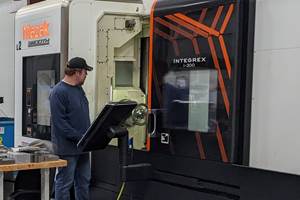Methods Seeks the Perfect Machining Environment
With its new Precision Center, Methods Machine Tools is locking down environmental variables that could impact machining processes. Why? So North American manufacturers will no longer need to send parts, tooling and material to Japan or somewhere else to have intricate, sensitive or challenging test cuts performed.
Share





With the crash of wooden mallets upon the lid of a sake barrel, Methods Machine Tools’ new Precision Center was officially open for business. The traditional Kagami biraki ceremony took place June 5 with executives from companies that have partnered with Methods to help test and launch the ultra-environmentally controlled facility.
At its core, Methods’ new Precision Center is meant to remove all environmental variables that could impact the performance of machining centers and equipment when extremely tight tolerances are required. Customers who may have difficulties achieving extremely tight tolerances, for instance, could turn to the center to rule out — or pinpoint — variables within their own facilities as the culprit. These variables fall across two broad categories: the climate conditions and air pressure within the room itself, and an ultra-solid foundation to minimize machine vibration.
The environmental control technology within the Center is akin to what one would imagine exists on the International Space Station. In order to maintain ideal air pressure conditions, visitors must first pass through a secured, pressurized airlock before entering the facility. Inside, four sensors on the walls and ceiling monitor temperature, air pressure and humidity. They feed that data back to a central control center, which then automatically adjusts ceiling fan speeds, moisture levels, and temperature by engaging or disengaging HVAC units, a water-cooling system and dehumidifiers. All of this takes place without human intervention.
To create the foundation for the Center, a construction crew removed rock and soil 1-meter deep and replaced it with isolated pads for each machine, made up of crushed stone and concrete reinforced with 0.625-inch steel rebar both horizontally and vertically. Methods says this will eliminate vibration and other physical interference that could emanate from the foundation itself during machining operations.
At the event, Jerry Rex, President and CEO of Methods, said that the Precision Center is the largest and most stable machining environment of its kind in the United States. He said that, prior to the grand opening, his team tested the environmental controls by cycling five machining centers for four weeks non-stop and discovered that the greatest temperature variation within any 24 hour period reached only 0.4° F. Because of the technology and stability in the Center, he said, North American manufacturers will no longer need to send parts, tooling and material to Japan or some other country to have their intricate, sensitive or challenging test cuts performed. “There are situations where the environment makes an impact on the machining process that you cannot have,” he said. “We have control over those variables now. Intricate, challenging, tight tolerance and confidential test parts can be made right here in the U.S."
In addition to test cuts and work on confidential parts, Mr. Rex mentioned that the Center will be used to develop new technology around machining practices and advanced turnkey solutions, as well as to develop new cutting tools and in-machine inspection processes. Joining Mr. Rex for the grand opening were Hiroyuki Uchida, Senior Executive Vice President and CTO, FANUC Corporation; Kenichi Nakamura, President Nakamura-Tome Precision Industries; James Hu, Chairman of Litz Hitech; Nobumasa Kiwa, President Kiwa Japan; Takuto Yasuda, President Yasda Precision Tools K.K. as well as owners and board members from Methods Machine Tools.
Related Content
5 Tips for Running a Profitable Aerospace Shop
Aerospace machining is a demanding and competitive sector of manufacturing, but this shop demonstrates five ways to find aerospace success.
Read MoreMultitasking Machines Cut Days From Shop’s Setups
Adopting WFL Millturn machines enabled BWXT to condense operations and setups while also providing a simple way to simulate and secure processes.
Read MoreSoft Skills Prove a Sharp Edge in Plastics Manufacturing
East Coast Precision Manufacturing’s uncommon specialties attract many customers — but its prompt, earnest communication strategy is what wins it repeat business.
Read MoreInverting Turning and Five-Axis Milling at Famar
Automation is only the tip of the iceberg for Famar, which also provides multitasking options for its vertical lathes and horizontal five-axis machine tools.
Read MoreRead Next
When Machining Long Parts, Machine Shop Climate Matters
Machining long titanium tufting needle bars required a milling machine with a super-long X-axis travel. But the real challenge was thermal compensation in the Georgia heat.
Read MoreAMRs Are Moving Into Manufacturing: 4 Considerations for Implementation
AMRs can provide a flexible, easy-to-use automation platform so long as manufacturers choose a suitable task and prepare their facilities.
Read MoreMachine Shop MBA
Making Chips and ¸ßĹâÂĘÁůşĎ˛Ę are teaming up for a new podcast series called Machine Shop MBA—designed to help manufacturers measure their success against the industry’s best. Through the lens of the Top Shops benchmarking program, the series explores the KPIs that set high-performing shops apart, from machine utilization and first-pass yield to employee engagement and revenue per employee.
Read More






















